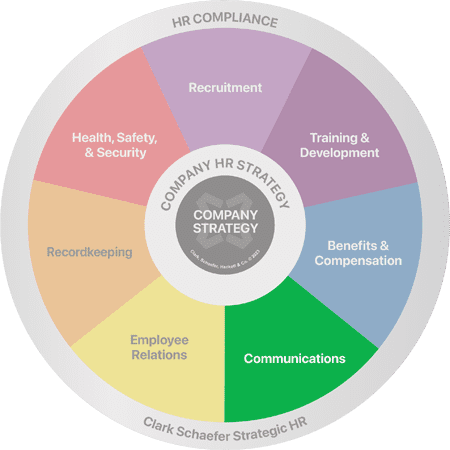Creating a Communication Plan for HR Programs
Last Updated on August 3, 2022 / Communications

HR Question:
We launched a new employee engagement program at the beginning of the year, and while people were excited at first, I’m afraid people may begin to forget about the program as we get busy in our routines. How do I make sure that this program sticks beyond the first few months of 2019?
HR Answer:
As we become more settled in our routines past the holidays, school breaks and weather interruptions, any new or improved policies that were put into place at the beginning of the year may be beginning to lose their sheen. It can be difficult to continue to reiterate new programs or campaigns, but to ensure the success of an initiative, extended communication and emphasis is important. It will be important to create an ongoing communication plan that continues to engage and energize your team to continue to invest in the company’s growth.
Whether it’s changes in benefits, or an employee engagement program, it’s important to continue to involve your leaders and team members to create a successful communication plan. When you’re doing so, make sure your messages and the benefits of your employees’ involvement are tailored to their needs and wants.
But when you remind your team of these plans is where it can get a little tricky. As HubSpot detailed in their report “Delivering Effective Internal Communications: Delivering ROI through Employee Engagement”, there is no “one size fits all” option for timing. While “when it becomes relevant” may be too vague of an option. Your communication plan will need to consider:
- When do you want to emphasize actions that are in-line with the company’s values?
- When do you think questions will arise?
- When will people need this information?
The more frequent these moments are, the more frequent you will need to remind them of the policy or initiative.
Who is going to be in charge of sharing this information, especially when things get busy or bogged down? Upper management and thought leaders may be the ones to first introduce the programs, but your managers and supervisors will most likely be the ones implementing the initiatives on a day-to-day basis. Make sure you’re earning their buy-in as well to create a comprehensive and successful communication plan, as they’re going to be the ones fielding questions, engaging employees, and reminding them of how this program will weave into their daily practices.
You next need to consider where or how you will share that information. Your communication plan for new or continuing programs, consider the various highways that information can travel on, and cater your style to those highways. In an article discussing new benefit roll-outs, thebalancecareer.com cited several different avenues of communicating a new initiative:
- Social Media – this wouldn’t be the place to detail each and every detail of a program, but the highlights or exciting aspects (if not confidential) would draw in individuals.
- Printed materials – in this case, you have information that can be documented, recalled, and quickly disseminated. It can be redistributed during times of peak action (i.e. open enrollment) or posted for everyone to review. Should you have a multi-cultural workforce, it’s best to have several versions of those materials in the different languages necessary.
- Web-Based Portal – whether it’s something like BambooHR, Paylocity, SharePoint, or simply Google Drive, having a web-based point of access for all employees can let them explore the information further.
- In-person – having informational meetings is a great way to get the information out all at once, while answering questions that several individuals may have at the same time.
It can be tough to introduce new programs, let alone earn the buy-in of the entire company while you do so. It all starts with a well mapped out communication plan in order to create an effective and established program. Don’t be afraid to ask for questions, send out reminders, and have check ins to make sure that this program is working for you and your employees. And if you need some help, don’t hesitate to call us at (513) 697-9855!
Communication often seems like a “no-brainer”. You have something to say and you just “say it”. However, hearing and listening are two different functions. HOW you communicate is often as important as WHAT you communicate when it comes to getting results! Strategic HR has years of experience preparing communications for a variety of audiences and topics. Visit our Communications page to learn how we can assist you with various communication-based projects.




